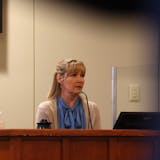PHILADELPHIA – Tens of thousands of horseshoe crabs from all over the East Coast climb like small army tanks from the Delaware Bay and onto soft, sandy beaches each spring, ready to spawn with females capable of laying 90,000 eggs a season.
They also carry within them a highly prized, copper-based, blue-colored blood that's used worldwide for testing vaccines and medical devices for toxins. In fact, as many as 750,000 horseshoe crabs were taken from waterbodies last year, and transported to labs. There, up to 40% of their blood was drawn before they were released.
Research has shown that up to 30% of horseshoe crabs tested can die as a result of the blood extraction process, said the Horseshoe Crab Recovery Coalition. The need for a vaccine for COVID-19 has stoked fresh worries about the decline of horseshoe crabs as more of their blood might be needed for testing. Horseshoe crabs that have had blood taken have showed less movement, a necessity for breeding and spawning.
"In a technologically advanced society, there has to be a better way," said Eric Stiles, president and CEO of New Jersey Audubon. Stiles has taken a lead role in the Horseshoe Crab Recovery Coalition, a group of 30 organizations that is urging that a synthetic alternative to blood be used instead.
Though horseshoe crabs are native to the mid-Atlantic, they are closely identified with the Delaware Bay. Their eggs provide food for 11 migrating bird species such as the red knot, a federally-threatened species. They are not considered endangered, but the number of Atlantic horseshoe crabs has been declining since at least the 1990s, the National Oceanic and Atmospheric Administration said.
Horseshoe crabs are not really crabs but more distant cousins to spiders. They are not venomous or dangerous, and their ancestors date back 450 million years. Their blood contains Limulus Amoebocyte Lysate (LAL), which clots in the presence of bacteria and is used to detect toxins that could find their way into vaccines, needles, and medical equipment. That blood is valued at $15,000 a quart.
The coalition is in favor of greater adoption of recombinant Factor C (rFC), a synthetic alternative to the blood. It is already being used in the manufacturing of two marketed medicines, the coalition said, and is recognized as an alternative by the European Pharmacopoeia, which helps to establish standards and protocols in the E.U.
The U.S. Pharmacopeia, has yet to follow that lead. It recognizes there might be alternatives to using horseshoe crabs, and has proposed qualifications needed for use of synthetic. A representative for U.S. Pharmacopeia could not be reached for comment. But, the coalition calls the proposal "a lengthy and burdensome pathway."



